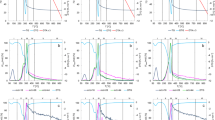Summary
The objectives of this research were to investigate the proportion of decayed wood in mature aspen stems, its chemical composition and its potential utility as a fuel or as a substrate for conversion to fine chemicals as part of an integrated utilization scheme. Three sound and ten decayed aspen stems were sampled from a boreal forest site. Stem analysis indicate that on average, 20% of the merchantable stem volume was in advanced decay and that considerable sound wood recovery was possible. Wood specific gravity and chemical composition were determined. The holocellulose content (volumetric basis) in advanced decayed wood was reduced by 67%. Thermal analysis of the wood using a differential scanning calorimeter provided graphical evidence of a different sequence of events occurring during the combustion of decayed wood and a resulting heat content per unit weight that was 40% higher than that of sound aspen wood. A higher degree of enzymatic hydrolysis was attainable with white-rotted aspen wood. Approximately 62% of the theoretical glucose yield was obtained from decayed aspen wood after alkali-peroxide pretreatment followed by a 12 hour hydrolysis using technical grade enzymes. The above information is used to elucidate future opportunities for wood recovery and energy production from decayed wood resources.
Similar content being viewed by others
References
Baldwin, R. C. and Streisel, R. C. 1985: Detection of fungal degradation at low weight loss by differential scanning calorimetry. Wood and Fiber Science: 17: 315–326
Blankenhorn, P. R.; Baldwin, R. C. Merrill, Jr. W.; Ottone, S. P. 1980: Calorimetric analysis of fungal degraded wood. Wood Science: 13: 26–31
Browning, B. L. 1967: Methods of wood chemistry. Vol. II, pp. 387–882. New York: Interscience-Wiley
Byers, C. H. 1988: An aspen simulation of fuel production by hydrolysis of wood biomass. Applied Biochemistry and Biotechnology: 18: 143
Davidson, A. G. and Prentice, R. M. 1968: Insects and diseases. In: Growth and utilization of poplars in Canada. Maini, J. S. and Cayford, J. H. Ed., Dept. of Forestry and Rural Development, Ottawa
Fengel, D. and Wegener, G. 1984: Wood chemistry, ultrastructure, reactions. 532–539. Walter de Gruyter, Berlin
Hiratsuka Y. and Loman, A. A. 1984: Decay of aspen and balsam poplar in Alberta. Information Report, Northern Forest Research Centre, Canada
Husch, B.; Miller, C. I.; Beers, T. W. 1972: Forest Mensuration. 410 pp. The Ronald Press Company, New York
Knoll, C. S. 1987: The chemistry of decayed aspen wood and perspectives on its utilization for the production of energy. M. Sc. F. Thesis. Faculty of Forestry, The University of Toronto, Toronto, Canada
Krigstin, S. G. 1985: Basic information on the factors responsible for the high energy in forest fuels. M. Sc. F Thesis. Faculty of Forestry, The University of Toronto, Toronto, Canada
Lachenal, D.; Choudens, C. de.; Monzie, P. 1980: Chemical pulping without sulphur. Alkali-peroxide pulping. Tappi: 63(11): 59–62
MacLeod, J. M.; Berlyn, R. W.; Gooding, R. W.; Cyr, N. 1982: Upgrading decayed aspen: chemical pulping-Part I. Tappi Proceedings. 961–970. 1982 Pulping Conference. Oct. 25–27, Toronto, Tappi Press, Atlanta
Pearl, I. A. and Busche, L. R. 1960: Studies on the chemistry of aspenwood, Part XI: The kalson lignin determination as applied to aspenwood with special reference to acid-soluble lignin. Tappi: 43: 961–970
Poplar Council of Canada 1981: Proceedings of the second annual meeting of the popular council of Canada. 120 pp. August 19–22, 1980 Richmond, B. C. Poplar Council of Canada and the Ontario Ministry of Natural Resources
Author information
Authors and Affiliations
Additional information
The authors would like to thank the Ontario Ministry of Natural Resources, Kirkland Lake for their cooperation; and for the technical assistance by Sally Krigstin, John Leigh, Samir Konar, Ganesh Deka and Doug Charles. We would also like to thank Dr. Morris Wayman, University of Toronto, for his advice and inspiration. We are especially grateful to the following persons and companies for supplying us with enzymes and their associated technical literature: Mr. John Bayard of Van Waters & Rogers Ltee, Canada, representing NOVO Industri, Denmark; Mr. Ian Hodge representing the Miles Biotechnology Group, Canada; and Dr. Gunther Eckert, B.A.S.F., Germany for obtaining and forwarding the products and information of Rohm GmbH, Germany. This work has been partially funded by the Edward Johnson Fellowship, University of Toronto
Rights and permissions
About this article
Cite this article
Knoll, C.S., Wong, B.M. & Roy, D.N. The chemistry of decayed aspen wood and perspectives on its utilization. Wood Sci.Technol. 27, 439–448 (1993). https://doi.org/10.1007/BF00193867
Received:
Issue Date:
DOI: https://doi.org/10.1007/BF00193867




